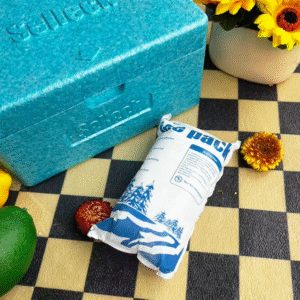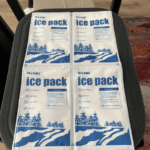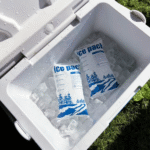Pack de glace carbonique du magasin à proximité: Comment le trouver et l'utiliser pour une expédition en toute sécurité?
Vous cherchez un moyen fiable de protéger vos marchandises périssables pendant le transport? UN sac de glace carbonique dans un magasin à proximité ça pourrait être ta solution. Apprenez à trouver, utiliser, et manipulez en toute sécurité les blocs de glace carbonique pour garantir des conditions optimales pour vos expéditions. Que vous envoyiez de la nourriture, médicaments, ou des échantillons biotechnologiques, ce guide contient tous les détails dont vous avez besoin.
-
Où trouver rapidement un pack de glace carbonique dans un magasin à proximité
-
Les avantages de la glace carbonique pour l’expédition de marchandises périssables
-
Comment manipuler et utiliser en toute sécurité les blocs de glace carbonique
-
Meilleures pratiques pour la conformité réglementaire dans le secteur du transport maritime
-
Choisir le meilleur fournisseur de glace carbonique dans votre région
Qu'est-ce qu'un pack de glace sèche dans un magasin à proximité, et pourquoi est-ce utile?
Un sac de glace carbonique d'un magasin à proximité est un produit de glace carbonique disponible chez les détaillants locaux tels que les épiceries., stations-service, et fournisseurs spécialisés d'entrepôts frigorifiques. La glace carbonique maintient des températures ultra basses (−78,5 ° C) pour de longues périodes, ce qui est essentiel pour expédier des articles sensibles à la température comme les fruits de mer, médicaments, et échantillons scientifiques.
Fait amusant:
La glace carbonique se sublime directement en gaz, ne laissant aucun liquide derrière, ce qui la rend plus efficace et plus propre que la glace conventionnelle pour l'expédition.
Où pouvez-vous trouver un pack de glace carbonique dans un magasin à proximité?
Vous pouvez trouver des blocs de glace carbonique à divers endroits tels que:
-
Épiceries comme Walmart, Safense, et Kroger
-
Stations-service (7-Onze, Waoua)
-
Fournisseurs industriels et entrepôts frigorifiques
Conseil: Appelez toujours à l'avance ou vérifiez en ligne pour confirmer la disponibilité des stocks.
Comment utiliser en toute sécurité un pack de glace carbonique d'un magasin à proximité
La manipulation de glace carbonique nécessite des précautions. Suivez ces directives pour garantir la sécurité:
-
Utilisez des conteneurs appropriés: Assurez-vous que la glace carbonique est stockée dans des conteneurs dotés d'une ventilation adéquate pour éviter l'accumulation de CO₂..
-
Porter un équipement de protection: Manipulez toujours la glace carbonique avec des gants isolants pour éviter les engelures.
-
Aérer la zone d'expédition: Évitez les récipients hermétiques pour éviter une accumulation dangereuse de pression due au gaz CO₂..
Meilleures pratiques pour l’expédition avec de la glace carbonique
Quelle quantité de glace carbonique devriez-vous utiliser pour l’expédition?
-
Pour 24 heures d'expédition, utiliser environ 1-2 lbs de glace sèche par 24-48 heures de transit.
-
Exemple: Lors de l'expédition de fruits de mer pour une journée, 2 des livres de neige carbonique suffiront.
Assurer la stabilité de la température pendant le transport
-
Superposez correctement la glace carbonique: Placez-le au fond de la boîte, s'assurer que les marchandises ne touchent pas la glace.
-
Utilisez des emballages isolés: Les conteneurs isolés aident à prévenir les fluctuations de température.
-
Sceller et étiqueter de manière appropriée: Une étanchéité et un étiquetage appropriés sont cruciaux pour la conformité réglementaire et un refroidissement efficace.
| Matériau d'emballage | Avantages | Meilleur cas d'utilisation |
|---|---|---|
| Conteneurs isolés | Garde le froid à l'intérieur, prévenir l'exposition à la chaleur | Expéditions à longue distance |
| Boîtes en polystyrène | Léger, rentable | Des expéditions plus courtes, surtout local |
| Sacs à l'aspirateur | Empêche le contact direct avec la neige carbonique | Marchandises délicates ou fragiles |
Conformité réglementaire pour l'expédition de glace carbonique
Veiller au respect des réglementations fixées par le POINT (Ministère des Transports) et Iata (Association internationale des transports aériens):
-
Conditionnement: Utilisation approuvée, matériaux conformes.
-
Étiquetage: Assurez-vous d'un étiquetage approprié comme « Glace sèche » ou « Dioxyde de carbone », Solide."
-
Limites de poids: Restez dans les limites de poids autorisées, typiquement 5.5 kg par colis pour le transport aérien.
Utiliser de la glace carbonique pour l’expédition de produits alimentaires
La glace carbonique est un choix populaire pour l’expédition de produits alimentaires, assurer des éléments comme fruit de mer, viande, et Repas surgelés rester à la température requise.
Meilleures pratiques:
-
Emballez en couches et surveillez la température des expéditions à l'aide de capteurs IoT ou de moniteurs de température..
2025 Tendances de l'expédition de la glace sèche
Avec l’accent croissant mis sur la durabilité et les progrès technologiques, 2025 verra des changements significatifs dans l’utilisation de la glace carbonique:
-
Solutions durables: Les options d'emballage réutilisables et biodégradables deviendront plus répandues.
-
Emballage intelligent: Des capteurs de température et des solutions de chaîne du froid basées sur l'IoT permettront de surveiller les expéditions en temps réel.
-
Conformité réglementaire: Des réglementations internationales plus strictes normaliseront les pratiques d’étiquetage et les exigences d’emballage.
Conseil: Gardez une longueur d'avance sur les tendances en optant pour des emballages intelligents et des solutions durables pour réduire l'impact environnemental et améliorer l'efficacité des expéditions..
Questions fréquemment posées (FAQ)
Q1: Comment trouver un magasin à proximité qui vend de la neige carbonique?
Vous pouvez facilement trouver de la glace carbonique dans les grandes épiceries, stations-service, et les entreprises de glace locales. Appeler à l'avance ou utiliser des localisateurs de magasins en ligne peut vous faire gagner du temps..
Q2: Puis-je expédier de la nourriture avec de la neige carbonique?
Oui, la glace carbonique est idéale pour expédier des aliments périssables comme les fruits de mer et les produits surgelés. Assurez-vous de suivre les bonnes directives d’emballage et d’étiquetage.
Conclusion et recommandations
Les packs de glace sèche des magasins à proximité sont essentiels pour garantir la sécurité, transport à froid de marchandises sensibles. Suivez les meilleures pratiques, rester conforme aux réglementations d'expédition, et choisissez le fournisseur de glace carbonique adapté à vos besoins.
Étapes suivantes:
-
Localisez un magasin à proximité avec des fournitures de glace carbonique.
-
Assurer un emballage approprié pour éviter la détérioration et maintenir les températures requises.
-
Explorez les options de surveillance de la température pour plus de tranquillité d'esprit.
À propos du tempk
À Rotation, nous fournissons des solutions de chaîne du froid de pointe, y compris des feuilles de glace carbonique, conteneurs isolés, et kits d'expédition sensibles à la température. Notre expertise garantit que vos expéditions maintiennent un contrôle optimal de la température tout au long du transit..
Prêt à expédier? Contact Rotation pour fiable, solutions professionnelles pour la chaîne du froid.
























